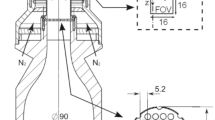Abstract
The interaction of heat release by chemical reaction and the flow dominates flame transition in swirling flows caused by combustion induced vortex breakdown (CIVB). The simultaneous application of 1 kHz high-speed particle imaging velocimetry (PIV) for the analysis of the flow field and OH planar laser-induced fluorescence for the detection of the flame front is particularly useful for the improvement of the understanding of the observed fast CIVB driven flame propagation. For the first time, the combination of both techniques was successfully applied to confined swirling flows. In the study, the flow field characteristics of an aerodynamically stabilized burner system with CIVB are analyzed in great depth. The influence of geometric parameters of the swirl generator was investigated and conclusions concerning the proper burner design of vortex breakdown premix burners are drawn from the experimental results. In particular, the effect of the vortex core with respect to the stability of the swirl stabilized burner is analyzed. The contribution of combustion to vortex breakdown is shown comparing isothermal and reacting flows. The presented data reveals that at the onset of CIVB driven flame transition, the azimuthal vorticity leads to the formation of a closed recirculation bubble at the tip of the internal recirculation zone. Once this bubble propagates upstream, the flame is able to follow and propagate relative to the bulk flow velocity with a velocity far beyond the turbulent flame speed. The interaction of reaction and flow was observed for different volumetric heat releases. The experiments confirm the CIVB theory of the authors, which was initially developed on the basis of a CFD study alone. Both the volume expansion and the baroclinic torque have an effect on whether fast flame propagation occurs. Whereas the volume expansion caused by the heat release stabilizes the flow field and the reaction, the baroclinic torque stimulates flame transition. For upstream propagation the flame tip has to have a position downstream of the stagnation point of the bubble. Else, the required transition inducing force is insufficient and the flame remains stable. In case the flame reaches positions too close or even upstream of the stagnation point, the fast propagation is interrupted or even prohibited. The key finding that the relative position of flame and stagnation bubble governs CIVB is discussed on the basis of high-speed LIF/PIV data as well as chemiluminescence. Since essentially the same behavior has been observed before in tests of a totally different swirler design and flow field, the conclusion can be made that the root cause for CIVB independent of the special geometry has been found.











Similar content being viewed by others
References
Asato K, Wada H, Hiruma T, Takeuchi Y (1997) Characteristics of flame propagation in a vortex core: validity of a model for flame propagation. Combust Flame 110:418–428
Ashurst WMT (1996) Flame propagation along a vortex: the Baroclinic Push. Combust Sci Tech 112:175–185
Brown GL, Lopez JM (1990) Axisymmetric vortex breakdown Part 2. Physical mechanisms. J Fluid Mech 221:553–576
Burmberger S, Hirsch C, Sattelmayer T (2006) Designing a radial swirler vortex breakdown burner. In: Proceedings of ASME Turbo Expo, Barcelona, Spain
Darmofal DL (1993) The role of vorticity dynamics in vortex breakdown, AIAA Paper 93–3036, 24th fluid dynamic conference
Duwig C, Fuchs L (2007) Large eddy simulation of vortex breakdown/flame interaction. Phys Fluids, vol 19, paper 075103
Fritz J, Kröner M, Sattelmayer T (2004) Flashback in a swirl burner with cylindrical premixing zone. J Eng Gas Turbines Power 126:276–283
Hasegawa T, Nishiki S, Michikami S (2001) Mechanism of flame propagation along a vortex tube. In: IUTAM symposium on geometry and statistics of turbulence. Kluwer, Dordrecht, pp 235–240
Ishizuka S (2002) Flame propagation along a vortex axis. Prog Energy Combust Sci 28:477–542
Kiesewetter F, Hirsch C, Fritz J, Kröner M, Sattelmayer T (2003) Two-dimensional flashback simulation in strongly swirling flows. In: Proceedings of ASME Turbo Expo, Atlanta, USA
Kiesewetter F, Konle M, Sattelmayer T (2007) Analysis of combustion induced vortex breakdown driven flame flashback in a premix burner with cylindrical mixing zone. ASME J Eng Gas Turbines Power 129:929–936
Konle M, Komarek Th, Sattelmayer Th (2007) Conditioned PIV-PLIF-measurements of CIVB driven flashback with 1 kHz repetition rate. In: Proceedings of the European combustion meeting, Chania, Greece
Konle M, Kiesewetter F, Sattelmayer T (2008) Simultaneous high repetition rate PIV-LIF-measurements of CIVB driven flashback. Exp Fluids 44:529–538
Kröner M, Sattelmayer T, Fritz J, Kiesewetter F, Hirsch C (2007) Flame propagation in swirling flows-effect of local extinction on the combustion induced vortex breakdown. Combust Sci Tech 179:1385–1416
McCormack P D, Scheller K, Mueller G, Tisher R (1972) Flame propagation in a vortex core. Combust Flame 19:297–303
Noble DR, Zhang Q, Shareef A, Tootle J, Meyers A, Lieuwen T (2006) Syngas mixture composition effects upon flashback and blowout. In: Proceedings of ASME Turbo Expo, Barcelona, Spain
Panton RL (1996) Incompressible flow. Wiley-Interscience, New York
Umemura A, Tomita K (2001) Rapid flame propagation in a vortex tube in perspective of vortex breakdown phenomena. Combust Flame 125:820–838
Acknowledgments
The authors gratefully acknowledge the financial support by the German Research Council (DFG) through the Research Unit Combustion Induced Vortex Breakdown.
Author information
Authors and Affiliations
Corresponding author
Rights and permissions
About this article
Cite this article
Konle, M., Sattelmayer, T. Interaction of heat release and vortex breakdown during flame flashback driven by combustion induced vortex breakdown. Exp Fluids 47, 627–635 (2009). https://doi.org/10.1007/s00348-009-0679-5
Received:
Revised:
Accepted:
Published:
Issue Date:
DOI: https://doi.org/10.1007/s00348-009-0679-5




